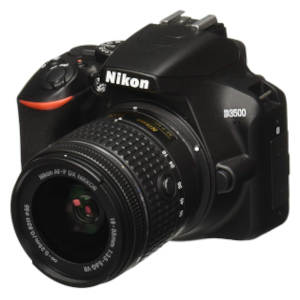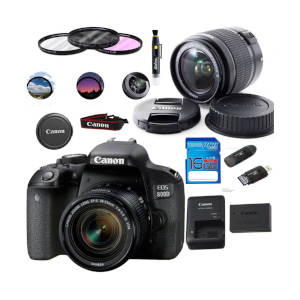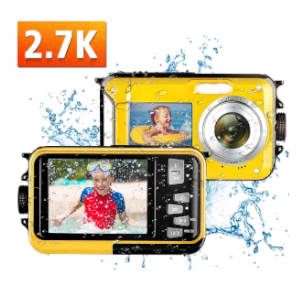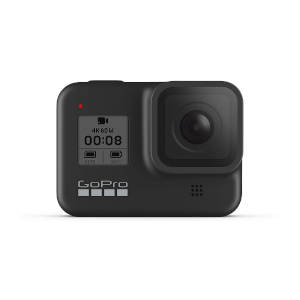I got into photography at the young age of 12 when I was assigned a school project to photograph old buildings in my town. I started saving up some money to buy my own camera and at 15, I was the proud owner of the cheapest Canon.
Having my own camera, it went wherever I went. I photographed everything in sight, and it goes without saying that I became my friends’ personal camera(wo)man. 10 years later, my obsession now lies with bird photography, better known as birding. I’ve been too proud to admit that my old Canon can’t deliver the quality that I need. But, I’ve made my peace with it; now that it’s time to retire my old buddy, I’ve been looking for the best point and shoot camera for birding.
Sure, there’s plenty to choose from, but it gets pretty confusing, to say the least. After months of research, I’ve shortlisted the 6 best cameras for birding within different price ranges, all with hopes that I can help some other fellow birder.
1. Nikon COOLPIX P900 Digital Camera
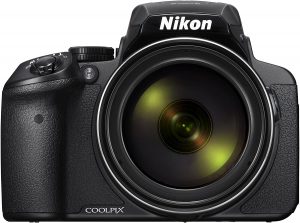 Right off the bat, I can immediately name the Nikon COOLPIX P900 digital camera as the best point and shoot camera for birding. With its superior 83x optical zoom NIKKOR Super ED VR lens and 24-2000mm equivalent focal range, it allows photographers to capture impressive close-ups.
Right off the bat, I can immediately name the Nikon COOLPIX P900 digital camera as the best point and shoot camera for birding. With its superior 83x optical zoom NIKKOR Super ED VR lens and 24-2000mm equivalent focal range, it allows photographers to capture impressive close-ups.
Logically, photos taken at the highest zoom levels are not as crisp as those taken at lower magnification, but the Nikon COOLPIX P900 can capture far off action in fine detail. This is mostly due to the fact that the camera gives plenty of magnification to back off, hence snapping clearer photos. To ‘back up’ the lens to a wider position to locate your subject and recompose, all you have to do is press a button. Although it doesn’t sound like much, this button is actually a game-changer when it comes to shooting at extreme focal lengths.
Many satisfied users have named this Nikon the undisputed king of the superzooms. For crisper photos, it comes with an advanced image stabilization system that offers 5 stops of shake reductions. Moreover, it has a secondary zoom controller which further reduces camera shake.
To easily track birds in flight, the P900 includes a high-resolution viewfinder. The electronic viewfinder turns on automatically when you lift it to your eye, providing extraordinary clarity. Nikon’s P900 gives you the chance to choose between different scenes, special effect modes, and manual exposure options.
Behind the glass is a 1/2.3” 16MP CMOS sensor which is not exactly considered professional grade, but it is definitely more than enough for amateur photographers like me. It supports Wi-Fi, NFC, GPS connections, and Hi-speed USB and HDMI output.
The only downside is the rather slow recovery time between photos, which I don’t really mind. As for battery life, you get 360 shots per charge.
Pros
- Great value for the money
- Beginner–friendly
- 83x optical zoom
- Advanced image stabilization system
- Secondary zoom
- High-resolution, electronic viewfinder
- Supports different connections
- GPS
- 360 shots per charge
Cons
- Slow recovery time between photos
2. Canon PowerShot SX60 HS
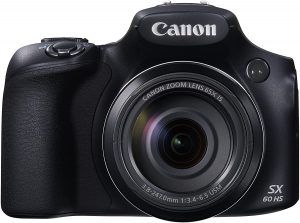 The earlier version of this camera, the SX50 HS, has been the go-to point and shoot camera in the birding community, so inspired by its fine pedigree, I gave the SX60 HS a chance.
The earlier version of this camera, the SX50 HS, has been the go-to point and shoot camera in the birding community, so inspired by its fine pedigree, I gave the SX60 HS a chance.
The Canon PowerShot SX60 HS boasts a whopping 65x optical zoom with a 35mm equivalent focal range of 21-1365mm. Looking at it, the camera resembles other superzoom bridge cameras, much like a small DSLR. You may think it’s a bit bulky, but considering the impressive zoom range, I have to say that at 127.6 x 92.6 x 114.3mm, the camera is anything but large. However, I have to admit that with its 650g, I do consider it to be a bit chubby.
As expected from Canon, the image quality is great thanks to the well-performing zoom lens and the 16.1MP sensor that captures images in RAW format. Due to the fact that it comes with variable focal length, it does not only perform well in different birding situations, but it will not let you down in other photography niches as well. In addition, it comes with 4x digital zoom and 260x combined zoom with optical image stabilizer.
The camera comes with advanced technologies rarely found in other cameras such as the Zoom Framing Assist and Intelligent IS that help photographers capture clear, steady long shots. On a negative note, I expected better low-light performance considering its high-sensitivity 16.1MP sensor and Canon’s DIGIC 6 image processor. However, the DIGIC 6 image processor does increase the camera’s overall performance by powering full resolution high-speed continuous stills shooting. It also enables 1080p full HD video at 60 frames per second. To top things off, you can also attach an external microphone!
Pros
- Affordable
- Easy to use
- Great image quality
- Optical image stabilizer
- Zoom framing assist
- Intelligent IS
- DIGIC 6 image processor
- External microphone input
Cons
- Chubby
- Average low-light performance
3. Olympus Tough TG-6
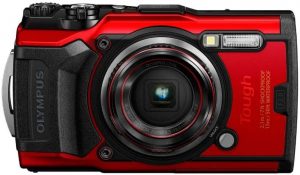 Takes a licking, keeps on ticking, the TG-6 is indeed one of the toughest cameras out there. It can go in the sea, survive dropping, can get covered in sand, and it’ll still work as a charm. The camera is waterproof, crush-proof, dust-proof, shockproof, and even freeze-proof. On top of it all, it is anti-fog as well!
Takes a licking, keeps on ticking, the TG-6 is indeed one of the toughest cameras out there. It can go in the sea, survive dropping, can get covered in sand, and it’ll still work as a charm. The camera is waterproof, crush-proof, dust-proof, shockproof, and even freeze-proof. On top of it all, it is anti-fog as well!
However, what I’m interested in is how well it will perform for birders. It features a 12MP backlit 1/2.3” sensor. At first I didn’t quite understand why it was downgraded from its predecessor, the Olympus Tough TG-4, which comes with a 16MP sensor. But, it turns out, the TG-6 performs better in low-light environments as the fewer pixels allow bigger photosite.
The TG-6 uses a 25-100mm full-frame equivalent zoom. Although it has an extraordinary macro feature, for close-up shots, I’d consider buying a light modifier that redirects light to surround the lens. In addition, you can upgrade the camera with fish-eye lens in case you need a wider angle of view.
As for connectivity, the TG-6 includes GPS, and is Wi-Fi enabled. Note that you have to keep the GPS off when you don’t need at as few users have reported that it drains the battery really fast. You can take up to 340 shots per one charge; that is if you don’t abuse the GPS and Wi-Fi features.
On a negative note, I really think that LCD screen should’ve been built more durable as easily picks up scratches and scuffs. But then again, the LCD screen is upgraded from the previous TG-5 model and packs 1,040 dots in a 3-inch frame. I found it to be extremely clear and since I often do in-camera edits, I certainly didn’t mind the sharp view.
Pros
- Tough
- Can withstand different weather conditions
- Add-on lenses and lights available
- GPS and Wi-Fi connectivity
- 4K video
- Sharp LCD screen
Cons
- LCD screen is prone to scratching
- GPS drains the battery
4. Kodak – PIXPRO AZ421-BK Zoom Digital Camera
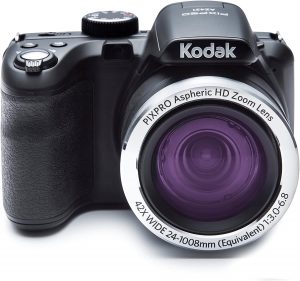 There’s a certain decline in Kodak’s popularity, but I’ve noticed that the one camera that will never go out of style is Kodak Pixpro AZ421. As one of the best entry-level bridge cameras, it offers premium image quality despite its rather low price tag.
There’s a certain decline in Kodak’s popularity, but I’ve noticed that the one camera that will never go out of style is Kodak Pixpro AZ421. As one of the best entry-level bridge cameras, it offers premium image quality despite its rather low price tag.
The Kodak Pixpro AZ421 is known among photographers are videographers involved in wildlife and nature photography. Of course, it managed to earn an outstanding reputation among birders which is what made me give this camera a try.
The Kodak Pixpro AZ421 comes with a 16.1MP sensor, while other cameras within its price range only have a 12MP camera sensor. In addition, it offers 42x optical zoom. The best part is that it doesn’t rely on digital zooming tweaks, hence resulting in better image quality as compared to cameras that use digital zoom to capture the same distance.
If you’re all about capturing the birds’ natural habitat, the 24mm wide-angle lens enables you to capture more with the same frame while helping you move closer to the bird. However, you do have to manually tweak the focus level which is not the case with higher price point cameras. But, it took me less than a week of playing with my Kodak to learn how to optimally tweak it, so all good on that front!
Its optical image stabilization technology helps minimize the disruption by movement or vibration. Regardless, I’d still recommend you use a tripod for optimal image stabilization when working at higher zoom ranges.
One possible drawback is the battery; it’s not that it won’t last, but it’s rather pretty inconsistent. I came across a number of customer reviews stating that it can provide 12 hours with one charge, 6 hours with the next charge, and 10 hours with the next charge.
Pros
- Affordable
- 43x optical zoom
- Optical image stabilization technology
- High-quality images
Cons
Manual focus level tweaking
Inconsistent battery
The four above mentioned models are what I believe the best point and shoot cameras for birding. Now that I’ve covered them in detail, I’m going to suggest you a few additional cameras that I’m only going to give a short overview of. You might as well find your best option here!
5. Canon EOS 7D Mark II Digital SLR Camera
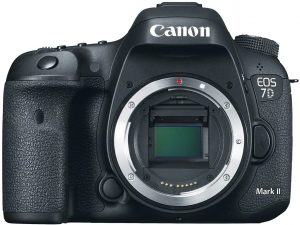 When it comes to birding, Canon EOS 7D Mark II Digital SLR camera has it all. Not only does it come with a large sensor and great ISO rating, but it also offers serious autofocus, a smart viewfinder, and much more!
When it comes to birding, Canon EOS 7D Mark II Digital SLR camera has it all. Not only does it come with a large sensor and great ISO rating, but it also offers serious autofocus, a smart viewfinder, and much more!
With its 20.2MP CMOS sensor, ISO 100-16000, and 7.5x optical zoom, you can rest assured you’re going to be capturing some high-resolution pictures. The 7D Mark II’s 65 point AF is perfect for getting snaps of birds while in flight, yes even in low-light situations. Unfortunately, there is no 4K video, but the HD video shooting did manage to produce movie-quality video.
A feature especially appreciated by amateurs is the intelligent viewfinder. It lets you shoot, change and confirm camera settings and shooting modes without having to look away from the viewfinder!
Pros
- Great value for the money
- Intelligent viewfinder
- Powerful 20.2MP sensor
- Allows high-speed shooting (10fps)
- Compatible with Wi-Fi adapter and SD slot
- Solid optical zoom
Cons
- A bit heavy for some
6. Sony a6500 Mirrorless Digital Camera
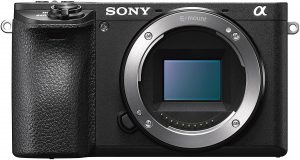 A major name in the birding community, Sony did it again; the a6500 mirrorless digital camera comes with everything you may need in a camera for a perfect day birding. With 24.2MP APS-C sensor with advanced processing up to ISO 51.200, it certainly packs a punch. Thanks to this advanced ISO power, you can even take dusk and dawn bird photography without distortion.
A major name in the birding community, Sony did it again; the a6500 mirrorless digital camera comes with everything you may need in a camera for a perfect day birding. With 24.2MP APS-C sensor with advanced processing up to ISO 51.200, it certainly packs a punch. Thanks to this advanced ISO power, you can even take dusk and dawn bird photography without distortion.
If you’re nearly as clumsy as I am, the toughness of the camera is among the key features you should consider before making a purchase. Well, the Sony a6500 can go down a rocky hillside and still go undamaged, although I do not recommend you try this.
I was really close to buying this camera mostly because of its 5-axis image stabilization. As I have shaky hands, I find this feature to be extremely useful. The viewfinder offers continuous shooting at 8fps, and you can record a video in 4K resolution.
Icing on the cake: it comes with a 4D focus! What’s more, the camera locks onto a subject in about 0.05 seconds, making it among the fastest seen AF acquisitions. That said, it works as a charm if you like catching birds in flight.
Sony a6500 is also compatible with all kinds of lenses, so it’s nice to know that you can upgrade your camera if you feel like you need more from it!
Pros
- Tough build
- 4D focus
- Powerful 24.2MP APS-C sensor
- Advanced ISO power
- 5-axis image stabilization
- 4K video quality
- Extremely fast AF acquisition
Cons
- Touchscreen doesn’t work that well
7. Panasonic Lumix FZ1000 Camera
 Although I’ve noticed that the Panasonic Lumix FZ1000 camera is considered the best point and shoot camera for birding among birders, I just couldn’t get over the fact that its camera body is large – at least for those with smaller hands. However, aside from this, it does come with some unmatched features which is why I have to recommend it!
Although I’ve noticed that the Panasonic Lumix FZ1000 camera is considered the best point and shoot camera for birding among birders, I just couldn’t get over the fact that its camera body is large – at least for those with smaller hands. However, aside from this, it does come with some unmatched features which is why I have to recommend it!
The Panasonic Lumix FZ1000 comes with the same 5-axis image stabilization as the above mentioned model does. Whether you have shaky hands or your other hand is taken with something else, you’ll rejoice at this feature as it takes away all the blur that may appear from using only one hand to take a picture. Even more, you can leave the camera on a tripod and control it from a certain distance thanks to the Wi-Fi feature.
This camera comes with a 20.1 MP, 1” MOS sensor which allows birding lovers to take some professional shots. In addition, it has 4K video capabilities and a 120fps slow-motion recording with the crispest sound.
The 16x optical zoom is ideal and 25 400 mm equivalent lens is ideal for all kinds of nature and wildlife photography. Macro photography down to 3cm has never been easier than with the Panasonic Lumix FZ1000!
The new DFD (Depth From Defocus) technology almost instantly calculates the distance between the camera and the subject by evaluating two images with different sharpness levels. Hence, and ultra high-speed AF is achieved.
There’s a vast array of accessory options you can choose from, but they come at a certain price. I really like the optional external flash that comes with a built-in LCD video light. Of course, you’re also given the option to add an external microphone too.
Pros
- 20.1 MP, 1” MOS sensor
- 5-axis image stabilization
- Wi-Fi connectivity
- Access to Panasonic app that allows to connect to a smartphone
- Macro photography down to 3cm
- Ideal for hobbyists
- Rugged design
- High-speed AF
- Multiple effects
- Compatible with different add-ons
- 4K video
Cons
- Bulky camera body
Verdict
The cameras I’ve just reviewed are best in the business when it comes to the best point and shoot camera for birding. Although there are at least 10 other cameras that are worth the consideration, I stuck to those options that I believe check all the right boxes.
As you can tell, the most important thing you should look for in a birding camera is a powerful sensor, solid optical zoom, and of course, great image stabilization technology. I think it’s of great importance that you pick a camera that has a strong build too, as you don’t know what kind of a hole you may fall in while chasing that magnificent bird.
I made sure to include cameras that will fit within most budgets, but you can always check my list of the best point and shoot cameras under $100 too!

